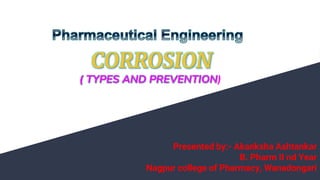
CORROSION.pptx
- 1. Presented by:- Akanksha Ashtankar B. Pharm II nd Year Nagpur college of Pharmacy, Wanadongari
- 2. CORROSION:- Corrosion is a natural process that converts a refined metal into a more chemically stable form such as oxide, hydroxide, or sulfide. It is the gradual destruction of materials (usually a metal) by chemical and/or electrochemical reaction with their environment.
- 4. Corrosion Engineering:- The branch of engineering that deals with the study of corrosion mechanisms and to prevent or control it economically and safely is known as Corrosion engineering.
- 6. General Attack Corrosion: •Also known as uniform attack corrosion. • Caused by a chemical or electrochemical reactions. • Ultimately, the metal deteriorates to the point of failure. General attack corrosion accounts for the greatest amount of metal Destruction. • Considered as a safe form of corrosion, due to the fact that it is predictable, manageable and often preventable.
- 7. Localized Corrosion: # Specifically targets one area of the metal structure. Localized corrosion is classified as one of three types: Pitting: •Pitting results when a small hole, or cavity, forms in the metal. •This area becomes anodic, while part of the remaining metal becomes cathodic, producing a localized galvanic reaction. •The deterioration of this small area penetrates the metal. •This form of corrosion is often difficult to detect .
- 8. Crevice corrosion: •Crevice corrosion occurs at a specific location. • This type of corrosion is often associated with a stagnant micro-environment. • Acidic conditions or a depletion of oxygen in a crevice can lead to crevice corrosion.
- 9. Filiform corrosion: •Occurring under painted or plated surfaces. •Filiform corrosion begins at small defects in the coating and spreads to cause structural weakness.
- 10. Galvanic Corrosion: •Galvanic corrosion occurs when two different metals are located together in a corrosive electrolyte. •Forms between the two metals, where one metal becomes the anode and the other the cathode. •The anode, or sacrificial metal, corrodes and deteriorates faster than it would alone, while the cathode deteriorates more slowly than it would otherwise.
- 11. Three conditions must exist for galvanic corrosion to occur: •Electrochemically dissimilar metals must be present •The metals must be in electrical contact •The metals must be exposed to an electrolyte
- 12. Environmental Cracking: ● It result from a combination of environmental conditions affecting the metal. ● Chemical, temperature and stress-related conditions can result in metal corrosion. The following types of environmental corrosion: #Stress Corrosion Cracking (SCC) #Corrosion fatigue #Hydrogen-induced cracking #Liquid metal embrittlement
- 13. Flow-Assisted Corrosion (FAC): •Results when a protective layer of oxide on a metal surface is dissolved. •Therefore exposing the underlying metal to further corroding. •Erosion-assisted corrosion •Impingement •Cavitation
- 14. Intergranular corrosion:- •It is a chemical or electrochemical attack on the grain boundaries of a metal. • Occurs due to impurities in the metal, commonly near boundaries . • These boundaries can be more vulnerable to corrosion than the bulk of the metal.
- 15. De-Alloying: • The selective corrosion of a specific element in an alloy. • The most common type of de- alloying is de-zincification of unstabilized brass. •The result of corrosion in such cases is a deteriorated and porous
- 16. Fretting corrosion: • Occurs as a result of repeated wearing, vibration on an uneven, rough surface. •Corrosion, resulting in pits and grooves. •Fretting corrosion is often found in rotation and impact machinery, bolted assemblies and bearings, as well as to surfaces exposed to vibration during transportation.
- 17. High temperature corrosion:- • It is the attack from solid or molten salts or gases at temperature above 400°C (750°F) . • Mainly occurs in gas turbines, diesel engine or other machineries coming in contact with hot gases. • Oxidation is the most common result of this type of corrosion. Ex.:- some fuels contains vanadium or sulphate compunds are strongly corrosive for stainless steel.
- 18. Various types of high temperature corrosion include:- ● Carburization ● Chlorination ● Fuel gas and deposit corrosion ● Nitridation ● Oxidation ● Sulphidation
- 19. Prevention of corrosion: ● Selection of corrosion resistant metals. ● Applying protective covering (ex.: Painting, galvanizing etc.) ● Applying dry powder coating. ● Protection metals from environment. ● Sacrificial coating. ● Corrosion inhibitors ( ex. : Passivation) .
- 20. Factors affecting during materials selected for pharmaceutical plant construction:- Properties: ● INTEGRITY ● ECONOMIC COST Major materials used: ● Stainless steel ● Glass ● Iron ● Tin etc.
- 21. Factors: 1.Chemical factors:- ● Contamination of products ● Corrosion of materials of construction
- 22. 2.Physical factors:- ● Strength. • Sterilization ● Mass • Transparency ● Wear properties ● Thermal conductivity ● Thermal expansion ● Ease of fabrication ● Cleaning
- 23. Rate of corrosion:- > Weight loss method FORMULA:- k= constant W= weight loss of metal in time “ T" A = surface area of the metal exposed Ro = density of metal (in g/cm³)